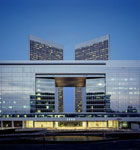Century Plaza Towers
Certification LEED Gold
Material Recycled 549 tons
Landfill Space Saved 1,758 yards3
Landfill Diversion Rate 51%
Water Saved 1.6 million gallons
Energy Saved 918,220 kW
Land development doesn’t get much more complicated anywhere than in Southern California. The state has a well-earned reputation for its strict building regulations, and its citizenry is equally vigilant about buildings in support of the public good. Most remaining parcels—particularly the large industrial ones—are brownfield sites left fouled by previous tenants.
But within those challenges lies the greatest opportunity to create value for the community, says Brad Cox, senior managing director of Trammell Crow Company’s Los Angeles office. Cox oversees a regional portfolio of 4.5 million square feet of premier office properties, including the landmark Century Plaza Towers in Century City and the award-winning Water Garden, and he directs the marketing and leasing of 2000 Avenue of the Stars, an 800,000-square-foot Trophy Class building that premiered in 2007.
“It was a phenomenal project and a pioneer development,” Cox says of the Avenue of the Stars address. “We were seeking to prelease the building in a market where historically there was a lack of preleasing. We were successful in landing Creative Artists Agency as a major tenant.”
2000 Avenue of the Stars
Certification LEED Silver
Material Recycled 363 tons
Landfill Space Saved 1,163 yards3
Landfill Diversion Rate 45%
Water Saved 47,885 gallons
Energy Saved 370,220 kW
Deal-making and developing in the sprawling Los Angeles area isn’t just about working near Hollywood. Cox is as an innovator who brings building sites back from the brink, helping businesses grow and communities experience rebirth.
Cox led the charge on the redevelopment of 33 acres in Sun Valley, much of which was a city trash dump that had been closed for four decades. Trammell Crow, with a corporate commitment to sustainability, worked through a morass of paperwork and processes to earn approval from 14 different regulatory agencies to convert the land to a viable property. The pad-ready parcel was eventually sold to FedEx for a 375,000-square-foot facility.
“We had unanimous community support and were ultimately able to deliver 200 new jobs on a site that has been unproductive and a community eyesore,” Cox says.
Cox grew up in Indiana, finished high school in Philadelphia, and attended the University of Arizona, where he earned a degree in marketing. Cox entered Mobil Oil Corporation’s training program but was drawn to commercial real estate in 1980 where he saw an opportunity for open-ended compensation based on his hard work and efforts.
He worked for Merrill Lynch, the Irvine Company, and Cushman & Wakefield, gaining extensive experience with high-rise office development before joining Trammell Crow Company in 2002. As office leader Cox raises capital, sets investment strategy, creates deal flow, advises on financing, manages assets, and oversees the day-to-day activities of the office.

2000 Avenue of the Stars (left) and Century Plaza Towers both achieved LEED-EB certification (Silver, and Gold, respectively).
He also chairs the Los Angeles Business Council and now the Business Council Institute, which helped the city establish the first green building code for a major city (a document that helped inform the California Energy Code).
Now Trammell Crow is assuming a leadership role in renewable energy by adding solar panels to the 1 billion square feet of industrial rooftops in Los Angeles County, aiming to harness the region’s 300 days of sunshine each year.
The company also implemented a “green light / red light” system for finding a parking space in a 6,600-space underground parking garage located beneath the Avenue of the Stars property, the largest of its kind on the West Coast. The lights guide drivers to open parking spaces and limit the time cars spend idling. Cox says the technology is estimated to have saved 173,000 gallons of gas—and the accompanying emissions—to date.
More is in the works for Cox and Trammell Crow. “Our goal,” Cox says, “is to be a market leader in sustainable strategies on storm-water retention, native landscaping, heat-load issues, rooftop solar, and buildings that are designed to be renewable-friendly. I think we have a personal obligation to make this a fabulous place … for our kids and grandkids. That requires you to take risks and be a market innovator.”


